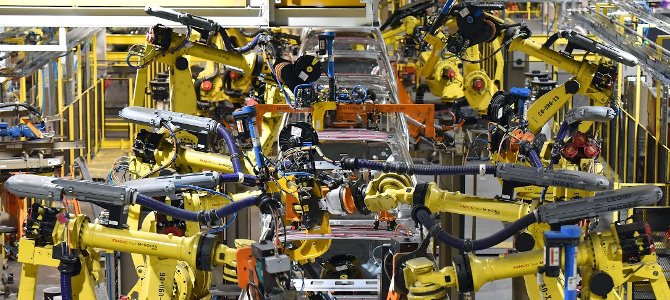
As Tesla has blown through one Model 3 production volume deadline after another, the automotive upstart’s “production hell” has become a topic of intense scrutiny and debate. Among fans of the company, the overwhelming majority of whom have little to no exposure to automotive manufacturing, the belief that Tesla must be innovating bold new manufacturing techniques that will leave the “legacy” automakers in the dust has become an article of faith. But if you spend some time at one of the established auto manufacturing plants that currently pumps out products and profits that Tesla can only dream of, it quickly becomes clear that the Silicon Valley startup culture that fuels Tesla’s innovative design and blistering performance is more liability than asset when it comes to the difficult task of actually making cars.
A recent visit to Ford’s Kentucky Truck Plant (KTP) put the contrast between Tesla’s approach to automaking and that of the established automakers into sharp relief. Even before I set foot in the massive facility, it became clear how much more confident Ford is in its manufacturing operation than Tesla. Whereas Tesla typically only opens its Fremont factory to Tesla owners who are required to sign nondisclosure agreements, Ford’s tour took select news media through nearly every portion of the plant (including the paint shop, which almost every factory limits access too), encouraged us to speak to any worker we liked, and asked only that we keep news of a new $25 million investment embargoed for a few days. If Ford were experiencing the “production hell” that has characterized every new Tesla product ramp we would have had no problem recognizing it.
What we saw instead was the intricate ballet of modern automotive manufacturing, a complex yet precise operation involving thousands of workers, robots and suppliers. We saw the fascinating mix of humility and pride among the workers who make up the foundation of the production system, the tight choreography of a fully automated body shop that turns sheets of aluminum into vehicle bodies, the firehose of data that keeps the entire system working together and the latest 3D printing technology that Ford has brought in to continuously improve –rather than replace– the humans and robots that move tirelessly to the beat of an unseen drummer. And at the end of the line, we saw that beat made manifest in a new Ford SuperDuty pickup, Expedition, or Lincoln Navigator rolling off the line at a steady rate of more than one per minute.
In short, nothing about KTP suggested anything that might be described as “production hell,” even as it produced more vehicles every day than Tesla makes Model 3 in a week. And though it may not have looked like an illustration from a speculative SciFi novel about the factories of the deep future, KTP also gave no indication of being a laggard in production or quality that might be disrupted by Tesla or anyone else.
Automakers like Ford are rightly frustrated by the public and market’s readiness to believe Tesla’s narrative about disrupting automotive manufacturing, but there’s reason to believe that the wildly different standards to which Tesla and other automakers are held actually hurts the would-be upstart. After all, one of the main reasons that KTP operates so efficiently and with such high quality is that it has no choice. Whereas Tesla has been able to count on investors and analysts to forgive its “production hell” fiascoes, KTP is the beating heart of Ford’s business, building some of the most high-margin and in-demand vehicles Ford has ever made.
With the new Expedition and Navigator flying off lots, the vehicles made at KTP are absolutely critical to the financial performance that markets demand. Since every minute of downtime means that at least one margin-padding truck or SUV won’t be delivered on time, the people of KTP know that the company’s financial performance depends on their perfect execution and attention to detail. Were Ford able to raise capital from the markets whenever its financial performance fell short, it’s easy to imagine a plant like KTP cutting corners or making excuses about “production hell.” But because Ford isn’t coddled like the self-described “disruptors,” workers here at KTP know that downtime and poor quality simply aren’t an option.
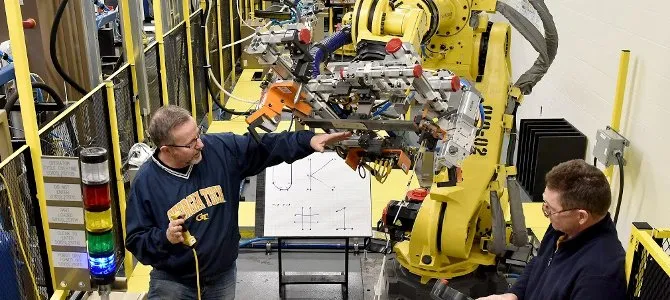
This reality becomes apparent during the first stop of the tour, a training center near the factory floor that features several robot installations and rows of computers. Because low-skill manufacturing jobs have largely been automated away already, the remaining jobs actually require more and more specialized skills all the time, increasing the need to turn abstract trade skills into real-world capabilities. Since those skills can’t be learned on the actual assembly line, which runs almost non-stop six days a week, plants like KTP increasingly require training centers like this one which allow workers to upskill without compromising the flow of trucks and SUVs rolling off the line.
And there is no shortage of new techniques that need to be learned. Over the past four years, Ford has been rolling out new versions of its trucks and SUVs that replace steel bodies with lightweight aluminum, necessitating entirely new body shop equipment and techniques. What appear at first glance to be rivets joining sheets of aluminum together into body components turn out to be a new technique that forms a rivet-like bond without actually penetrating one of the outer sheets, eliminating any chance of leaks. New joining techniques like this, as well as the use of industrial adhesives and some spot welding, keep trucks and SUVs a step ahead of increasing fleet fuel economy standards, but they also require body line workers learn new skill sets at this training center and create a clean break from the past practice of welding-heavy steel construction.
But even with a dedicated training center, the novelty of these techniques mean that challenges still crop up on the factory floor, threatening Ford’s financial lifeblood. To address them with a minimum of downtime, the automaker has turned to a hot technology: 3D printing. In an onsight “innovation center,” Ford uses an additive manufacturing machine to rapidly develop and iterate tools to help workers build vehicles at high quality. It’s the first example I’ve seen of 3D printing being used at an automotive assembly facility, and the way that Ford uses it shows how steady advances –rather than disruptive leaps– characterize automaking, even when it comes to the most heavily-hyped new technologies.
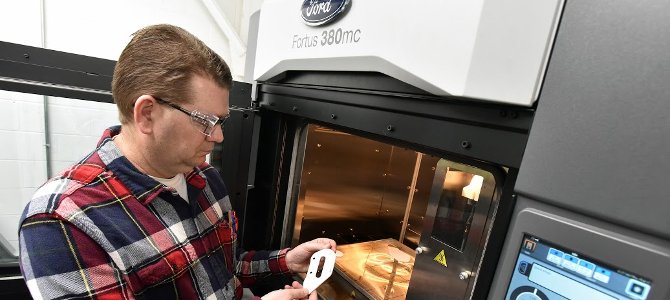
One of the techniques Ford uses to join its aluminum truck and SUV bodies is called a “flow-drill screw,” a threaded fastener that uses torque to grip a section of metal sandwiched between two sheets of aluminum. To work properly these screws must be driven in at the precise points where the sandwiched medium is engineered to grip the screw threads, but because those points are covered by the aluminum sheets they are “blind holes” that can’t be seen by the screw gun operator. When workers began struggling to hit these blind holes with the necessary precision, the plant’s innovation center 3D printed a plastic jig to guide the screws into the proper position. Not only did the additive manufacturing technique allow that tool to be developed faster and cheaper than any machine shop, it also allowed workers to rapidly iterate new designs that more readily slotted into the precise position.
At a time when 3D printing is still hyped in certain circles as the future of technology, it’s worth taking a moment to appreciate the pragmatism of this use case. When it comes to the parts that actually make up modern vehicles, 3D printing’s greatest strength –its flexibility– is not as important as the low cost and high quality of more traditional manufacturing techniques. But as a way to rapidly develop and iterate tools that assist in the manufacturing process, helping workers overcome challenges as they emerge in the course of production, one 3D printer can save money and cut downtime that might otherwise be wasted while a machine shop creates a required tool. Especially at a plant like KTP, which has to keep downtime to an absolute minimum or risk impacting the entire company’s financial performance, a 3D printer represents an important tool for the “continuous improvement” (kaizen) of the production system… as well as a sign that automakers are not standing still when it comes to new technologies.
Knowing when and where to target these improvements presents another opportunity to embrace technology, and here too Ford’s truck plant is pushing ahead. In the giant body shop area at KTP there’s a massive data analytics center tracking every step of the immense system of robots that transforms stamped aluminum components into truck and SUV bodies. On a wall of giant monitors, a map of each body line station turns a flood of data into a quickly-comprehensible real-time map showing the status of each process, its rate of work and its relationship to the processes ahead of and behind it. Above this map, another row of monitors shows camera feeds from each station allowing workers to identify problems on the far end of the shop as soon as a station turns red on the map, indicating that it has gone down.
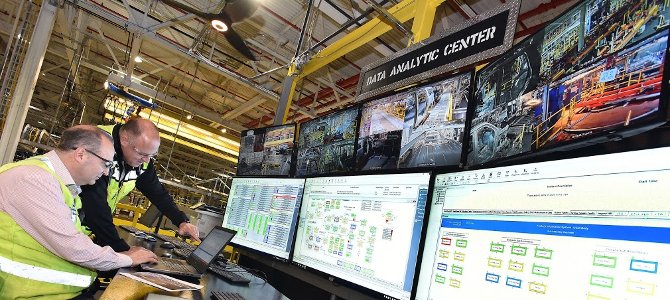
Like most automakers, Ford has been collecting the huge volume of production data generated by its factories for years, analyzing it for opportunities to optimize its production system as well as tracking the parts that go into each car in case a defect is discovered and needs to be recalled. What this data analytics center represents is a more recent effort to push that data to workers on the factory floor, turning a firehose of data into a format that can be quickly and easily monitored. As with all big data projects, the challenge lies in displaying only the information needed to monitor the system while still allowing workers to dive as deep into the data as necessary.
Here again, Ford is not shying away from the challenges and opportunities presented by new technology. The skills required to manage and make sense of so much data, particularly in creating a convenient yet powerful interface for workers, are relatively new to automotive manufacturing but based on a brief explanation and a few minutes of study the new shop-floor data analytics interface seems well-designed. It’s not as sexy as a consumer-facing software interface, but it also isn’t as abstruse as a lot of other industrial software. The fact that it can make the basics of a system as complex as KTP’s body shop comprehensible to this layperson in relatively short order shows that even the auto industry’s metal benders are keeping pace with technological progress.
Eventually Ford’s KTP tour ends up in a part of the plant that is rarely open to visitors: the paint shop. Typically access-limited due to the sensitivity of automotive paint to contamination, this is the first paint shop I have ever been inside of in years of visiting auto assembly plants. Donning a protective smock, select members of the group are tested for invisible deodorant and lotion residues that might create paint defects if we were to enter a paint booth before we are ushered into one of the most sensitive and important areas of the plant.
KTP’s newest paint shop is one of the most advanced in the world, using the “three wet” process that Ford innovated and Tesla adopted for its Fremont plant (along with much of the industry). With ultra-low VOC emissions and a “dry scrubber” that eliminates the huge amounts of waste water once used by automotive paint shops, the new paint shop is as environmentally friendly as paint shops come. But two paint shops using the same equipment can create profoundly different results: the deep, lustrous and even tone of the vehicles coming off the line provide a stark contrast to Tesla’s paint jobs, which are universally recognized as being thin, fragile and inconsistent.
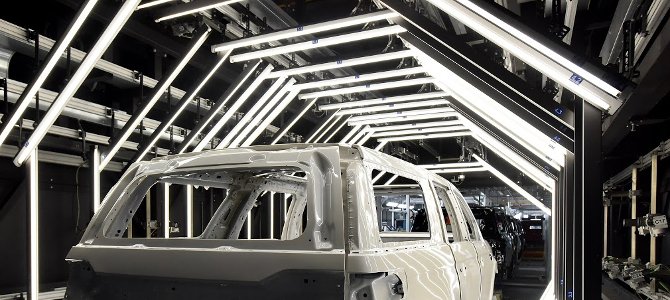
Here too, Ford is using cutting edge new technology to drive high quality. After emerging from the paint line, vehicles roll through a tunnel filled with high-intensity lights and cameras hooked up to a machine vision system that highlights tiny defects and inconsistencies that are barely visible to the naked eye, marking them on an overhead screen so workers can correct them. At the Ford plant in Valencia, Spain where this computer vision quality control system was first deployed, workers went from spending 70% of their time visually inspecting vehicles to spending just 10% of their time looking for defects, and at KTP the paint shop now gets over 99% of paint jobs right on the first trip through the line thanks to the high-tech system.
But for all of KTP’s adoption of cutting-edge technology, from machine vision and data analytics to 3D printing, there’s a major philosophical difference between the way Ford seems to be implementing advanced manufacturing and the way Tesla talks about the same topic. Whereas Tesla CEO Elon Musk bemoans the slowness of modern auto manufacturing and holds forth a vision of a radical transformation to factories that require no human workers, human employees remain the foundation upon which KTP’s (and by extension, Ford’s) manufacturing success rests. Rather than identifying humans as the barrier to efficient manufacturing and developing technology to replace them, as Musk seems to, Ford is adopting technology that empowers human workers to become better at their jobs, and thus more irreplaceable than ever.
“I think all of us who have spent any time in manufacturing plants would recognize that there is a significant amount of problem solving that goes on every day in real time,” Ford’s Executive Vice President and President of Global Operations Joe Hinrichs says, when asked about the future of human labor in Ford’s manufacturing. “And that can’t be done by robots or an automated system. A part comes in that’s fitting a little different than it was yesterday, or a machine is acting a little different than it did yesterday, or something breaks down or there’s a communications fault… importantly, the eyes and ears and experience of the people out there help us. They’re not just laborers, they help us produce better product…. So there’s a human element to this that’s really important and I don’t see that going away any time soon.”
“Now, I don’t know what 30 years from now looks like,” Hinrichs continues. “But I can tell you we’re using automation where we think it makes a better product or eliminates a problem like ergonomics issues or safety or where the tolerances are so tight and need to be so consistent every time that you need a robot or automated system to do that. But it’s also really difficult to do a lot of things using an automated system because there’s finessing, or getting around things or getting into things… And there’s a significant amount of inspection out there… lots of eyes on that vehicle to make sure that it’s ready to go when it leaves here.”
Though Hinrichs admits that some industries, silicon wafer manufacturing is the example he gives, where fully automated manufacturing is already being done. But the size and complexity of cars, the near-infinite potential variations in the thousands of parts that go into them and the thousands of processes through which they are made makes cars unique in the manufacturing world. “You saw, there’s a lot of robots out there,” he says, gesturing toward the factory floor. “But there’s also 8,400 people. I don’t see that changing in the automotive space any time soon. I don’t think anyone here is pandering when we say that’s how important the workforce is. When the workforce is aligned and inspired and pulling together, this place can do things that we can only write down on paper and hope for.”
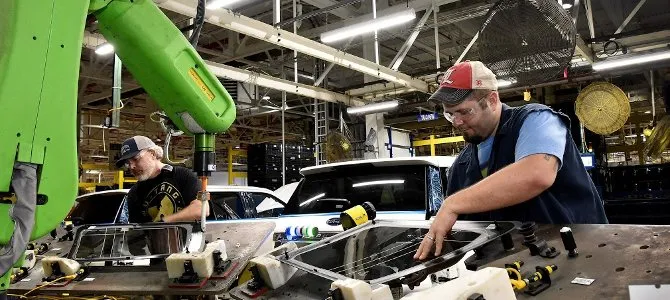
At a time of intense technological change in so many other parts of the economy, Hinrich’s words are an important reminder that humans are more than just a source of problems to be solved with technology. When united behind a shared vision and supported by the latest technology, humans are capable of doing things that robots may never be able to do. Certainly the people who come in to KTP every day seem to radiate a pride in their work that is reinforced by the fact that the plant’s latest technology exists to support, rather than replace, them.
Yes, the auto industry has lost a lot of jobs in the past few decades, and Hinrichs doesn’t shy away from the fact that there are some jobs that may yet be automated away. But, he explains, now that most of the drudgery work that used to characterize factory work has been automated away, the trend is now moving towards ever more intelligent, experienced and proactive workers on the factory floor. And although this new generation of workers will need new skills in coding or communication technology, they’ll still also need to be deeply versed in the system they are part of: the massive yet intricate web of relationships and processes that transforms raw materials into profitable cars, trucks and SUVs. The car plants of tomorrow don’t just need programmers and technologists, it needs people who know how to apply those skills to what remains an extremely human-based system of production.
When Musk talks about factories without workers, he’s clearly not drawing on a wealth of experience manufacturing vehicles, but is playing to a cultural perception that technology is changing everything. He’s been successful at doing so because technology is changing everything, and because the public is so rarely exposed to car factories it’s easy to imagine that they are as vulnerable to technological disruption as feature phones or film cameras. But if you spend some time amongst the thousands of people who work at a major vehicle plant, if you see the way they work and the way that technology is being used to enhance rather than replace them, you might just begin to understand why manufacturing experts generally respond to Musk’s pronouncements on the topic with a chuckle.
Besides, the beauty of manufacturing is that it almost doesn’t matter what you think or say: when you make things, only the results speak for themselves. And every sixty seconds, when another truck or SUV rolls off the line at KTP looking showroom-perfect, the people of this factory quietly yet proudly announce that they are here to stay. All you have to do is learn how to listen…
Disclosure: Ford paid for airfare, lodging and food during my one-day visit to KTP.





